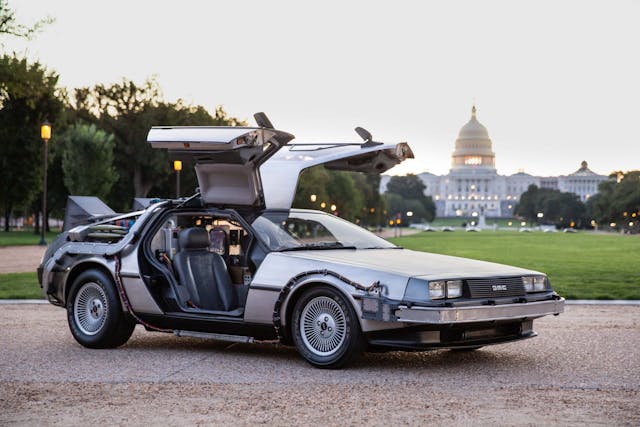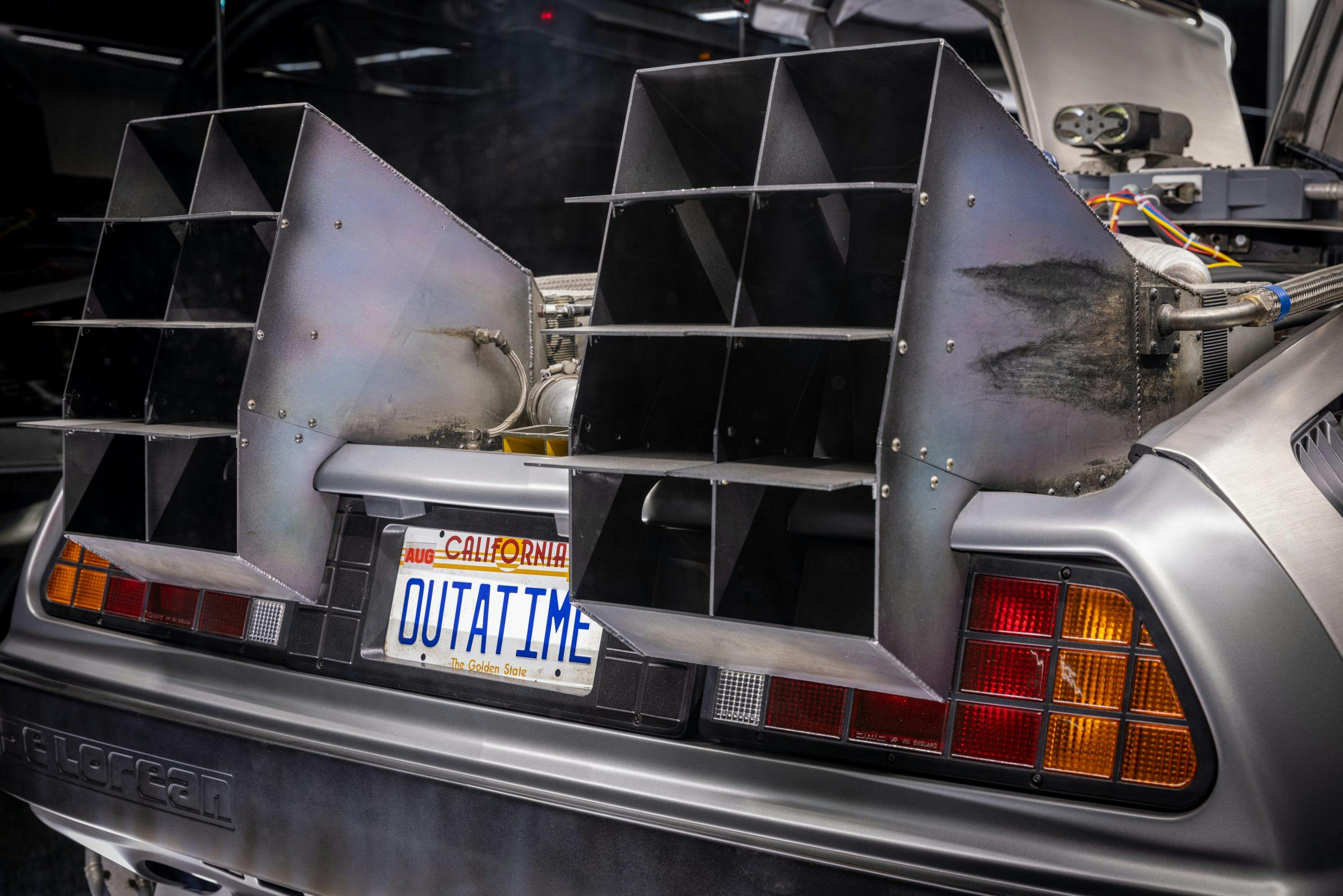Media | Articles
Back to the Future DeLorean back in the spotlight in star-studded documentary
If there was any doubt about the iconic status of the Back to the Future DeLorean, it is quickly dispelled in a new documentary released by the Hagerty Drivers Foundation. In the first three minutes of 88mph: The Story of the DeLorean Time Machine, no fewer than 13 enthusiasts—including movie stars Michael J. Fox and Lea Thompson—appear on screen to tout the staying power of the fictitious time machine that first appeared in the original 1985 film. And many more weigh in during the next hour and a half.
“There are a lot of movie cars, but it’s hard to imagine one that’s more recognizable than the Back to the Future DeLorean,” says Oliver Holler, who teamed up with his wife, Terry, to build a replica time machine that they use to raise money for the Michael J. Fox Foundation for Parkinson’s Research. “Our memories take us back in time, and our hopes and dreams and imagination take us forward. You’d be hard-pressed to find another car that can do that.”

“I think it’s the most important movie car, period,” adds Terry Matalas, who took part in a labor-intensive restoration of the movie’s hero car. “It’s perfect.”
“The DeLorean Time Machine,” says Donelle Dadigan, president and founder of the Hollywood Museum, “is part and parcel the fabric of American pop culture.”
As we learn, however, it’s a whole lot more than that.
Marketplace
Buy and sell classics with confidence
Weaving together original film clips, news stories, and interviews, along with fresh sit-down sessions with the key players, the documentary covers the rise and fall of John Z. DeLorean and the DeLorean Motor Company, the friendship of Hollywood filmmakers Robert Zemeckis and Bob Gale, the origin story of the script, the creation of the DeLorean Time Machine, the overwhelming popularity of the film, the deterioration and eventual restoration of the hero car, and the amazing staying power of the film—and the 1981 DMC-12 that became the time machine—more than 36 years after the movie’s release.
Gale says he was always fascinated with science fiction, particularly time travel. He and Zemeckis met as undergrads at the University of Southern California, became fast friends, and planned to make movies together. The two came up with an idea that they called Professor Brown Visits the Future, about a crazy professor who invents time travel, but they never figured out a storyline.
Then, in 1980, the friends made a movie together called Used Cars, and while Gale was visiting his hometown of St. Louis to promote the film, he stayed at his parents’ house. Looking through his father’s 1940 high school yearbook, he learned that his dad had been class president. Gale thought about his own school’s class president, who he found annoying, and wondered what his own father must have been like as a teenager.
“Bingo, that’s when the lightning bolt struck me in the head,” Gale says. “That’s the hook. Kid goes back in time and ends up in high school with his dad.”
Zemeckis and Gale pounded out a script. It was rejected. Forty times. Then Zemeckis made the hit Romancing the Stone, and his reputation rose. The timing was perfect. Their friend Steven Spielberg was just starting Amblin Entertainment at Universal, and he liked the script, so Back to the Future became Amblin’s first project. During that time, John DeLorean found himself in legal trouble, and although he was eventually found not guilty of drug trafficking, DeLorean Motor Company went belly-up.
With John DeLorean’s woes all over the news, Zemeckis had a suggestion. Instead of basing the movie’s “time chamber” on a refrigerator, how ’bout using a DeLorean instead? Gale thought the idea was brilliant. History proves he was right.
In the meantime, Universal had cut the film’s budget, so in addition to making changes to the script, the studio was also pushing for onscreen product placement. Gale liked the idea of showing Pepsi instead of Coca-Cola, because the Pepsi logo changed over the decades (unlike Coke) and “helped define the period.” But he had to draw the line somewhere, and that somewhere was the car. Ford offered $75,000 if the creators were willing to swap a Mustang for the DeLorean. Gale’s response was priceless.
“Doc Brown doesn’t drive a f**king Mustang,” he said. “Get outta here.”
The DMC-12 stayed.
When it came to building the time machine, Gale says it “had to look like Doc Brown built this thing in the garage. It had to look earthy. It had to look dangerous.”

Andrew Probert took the first stab at it, but his first drawings made the car look too polished, so Ron Cobb was brought in for a couple of weeks and asked to put his own spin on it. Probert then finished off Cobb’s concept art, which had to be translated into an actual car. Mike Fink, who had worked on vehicle design in Blade Runner, was brought in to make it happen, along with special effects supervisor Kevin Pike, who had just opened Filmtrix Inc., in North Hollywood. When Fink had to jump to another project, the filmmakers turned to Michael Scheffe, who had worked on the creation of another star car, the Knight Rider Trans-Am.
All five men left their mark on the DeLorean Time Machine, but perhaps no one more than Scheffe.
“Half the junk I chose was stuff that I couldn’t identify, because I figured if I didn’t know what it was, no one would know what it was, and then it wouldn’t be like a red flag to people watching the movie,” he says. “It’s a delicate line. It has to look silly enough [that] you go, ‘Oh, come on,’ and it has to look believable enough that you say, ‘Yeah, maybe.’”

He also had to make a change that only the sharpest of fans will notice. The DeLorean’s actual speedometer topped out at 85 mph. Big problem, considering the time machine activated when the car reached 88 mph. So Scheffe’s team had to create a new template that went up to 95 mph.
Three DeLoreans were purchased for the original movie (which evolved into a trilogy of films). The “A car” was the most detailed and became the hero car; the “B car” was designed for exterior shots, but it soon became a detailed duplicate; and the “C car” was cut up a bit and used as a “process car” outfitted with a Panaflex camera. Four other DeLoreans were added while producing the two follow-up films.
The time machines met different fates after the movies were completed. The hero car was the most visible, going on display at Universal Studios and appearing at other promotional events. Eventually, however, it was parked in a back lot, uncovered, and began to waste away.
Years passed before an amazing team of Back to the Future enthusiasts restored the star car on behalf of Universal. It was a labor of love that required long hours of tiring work, which was sometimes interrupted by arguments about just what should be done. In the end, to honor all of those who had a hand in creating the original movie car, the DeLorean Time Machine was restored to look exactly as it did when it backed off Doc Brown’s truck and Marty McFly saw it for the first time.

“It really did stand the test of time,” Scheffe says. “… It’s been an unbelievable privilege to see that happen, just to be connected to it.”
“It’s a part of our culture,” says DeLorean Time Machine replica builder Sean Bishop, who worked on the restoration. “Not just pop culture—it’s a part of our culture. And it deserves to be remembered as such.”
The movie car is now listed on the National Historic Vehicle Register, and rightly so. Imagine how differently we might view the DeLorean without its connection to Back to the Future.
“This car could have been just a footnote in history. [Instead] it ended up being an icon,” says DeLorean historian Tamir Ardon. “And that was because of what the Bobs did by implementing it into one of the greatest sci-fi films ever made.”
Even John DeLorean thought so. In July 1985, he sent Zemeckis and Gale a letter thanking them for “immortalizing” the DMC-12, calling the film “brilliant.”
Says Gale, “You can’t think of Back to the Future without thinking of the DeLorean, and you can’t think of the DeLorean without thinking of Back to the Future.”
Great Scott, he nailed it.



























